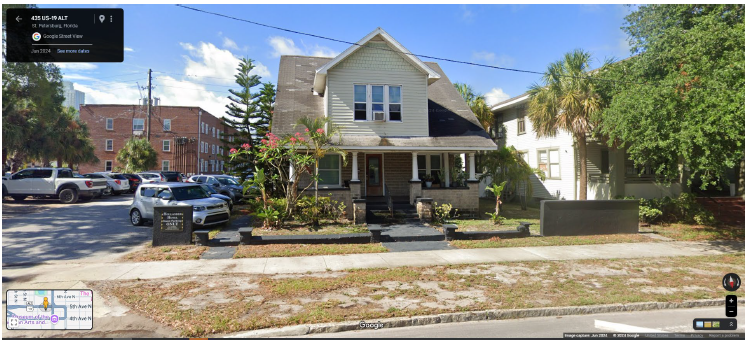Developers of the newly branded "Pelican" residential tower have submitted updated plans to the City for a proposed 20-story residential project at 5th Ave. N and 4th St. N., and the changes could not be more black and white.
In their update, submitted at the urging of the Development Review Commission, the renderings of the new tower are white. In their previously submitted proposal back in August, the renderings of the tower were black. The project will be heard during the November 5th DRC meeting.
Scale, Mass, and Compatibility
Since the project first appeared, PTB and others have voiced concerns centered around the Pelican's height, massing, and compatibility with the surrounding neighborhood. Rather than adjusting those elements, the applicant’s latest submission mostly focuses on producing more attractive renderings of the same design, which dodges the real issue: whether this tower belongs in this context at all.
At 7 FAR (floor area ratio) and 200+ feet high, the Pelican would dominate its surroundings. Its 450-foot-long parking garage façade would stretch nearly an entire city block along 5th Avenue North, creating a wall-like effect at a key downtown gateway. The proposal is also situated where three National Register Historic Districts meet: Downtown, Round Lake, and Northshore.
Bonuses Are Not Entitlements
The development team has requested height and density bonuses, but it's important to note that these are requests, and are not guaranteed. Under the DC-2 zoning district, extra height must be earned by showing compatibility and alignment with the city’s design goals, including City Code: Sec. 16.20.120.3.3 (DC-2 District), which states, "heights in this district begin to taper down as development sites become less proximate to the core and transition to surrounding neighborhoods.”
Even if city staff interpret the rule narrowly (They do!), the Development Review Commission (DRC) still has full authority to find that the Pelican’s massing is simply too much for this particular site.
.png)
Precedent for Better Projects
St. Petersburg has a record of improving developments through community input. Projects like Bezu/Blue Lotus/Julia and 200 Mirror Lake, above, were initially denied because of scale concerns and both later returned with revised, more compatible designs that ultimately earned approval.
The same outcome could happen here. With design adjustments and a more thoughtful approach to context, this project could evolve into something that truly complements its surroundings.
Historic Housing Matters Too
Beyond architecture, there’s a vital housing story unfolding on this site. The Pelican proposal would replace 74 existing apartments, many of which qualify as “naturally occurring affordable housing” (NOAH): Older, smaller units that remain attainable without subsidies.
Losing those units is a loss of affordable downtown housing. St. Petersburg’s own Comprehensive Plan and related policy documents repeatedly call for the protection of historic and affordable housing stock:
Objective H7: The City shall identify and preserve historically significant buildings.
Policy H7.3: The City shall discourage demolition of historic resources within or eligible for National Register districts.

Retaining Older Housing Stock = Affordability
When we talk about housing affordability, it is often framed as building new units using subsidies or tax credits. Often left out from the discussion? Retaining the units we already have.
According to the “Keeping the Vibe Alive” report by PlaceEconomics, commissioned by Preserve the ‘Burg in 2024, older buildings are playing a major role in providing affordable housing in St. Petersburg. For example, over 81% of small-scale multifamily buildings in the city were built before 1960.
Smaller, older homes and multifamily units might not appeal to certain renters or buyers, but they do provide real options for working residents, students and those earning less than the area median income, while others may just prefer living in a historic property with its unique features and identity. Protecting modest historic apartments isn’t just about nostalgia. It’s about housing diversity, sustainability, and maintaining neighborhood character, all of which are pillars of the city’s St. Pete 2050 vision.
A Better Path Forward
Saying “no” to the Pelican as currently proposed isn’t saying no to development, it’s saying yes to better development. As we’ve seen before, thoughtful revision and collaboration can yield projects that respect both the city’s growth and its history. We believe the same outcome is possible here.
Want to weigh in? You can submit public comments to the DRC before Nov. 5. Email them at drc@stpete.org.